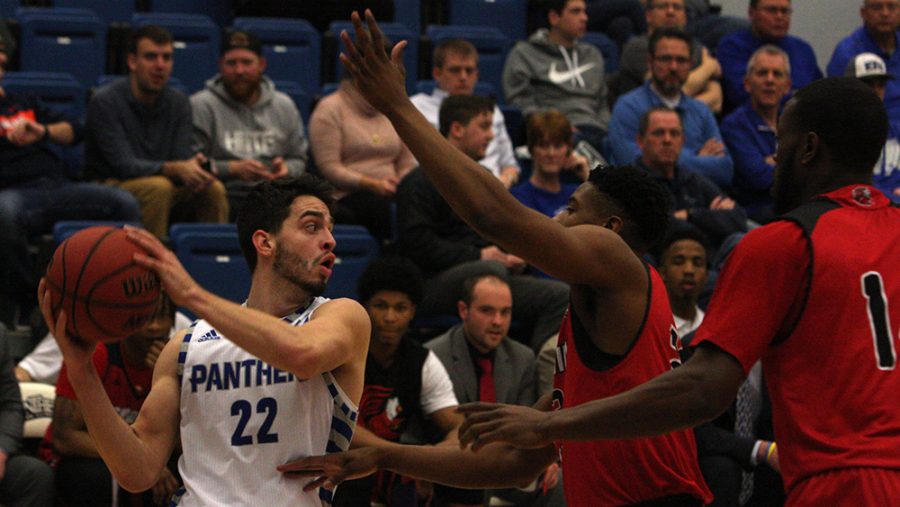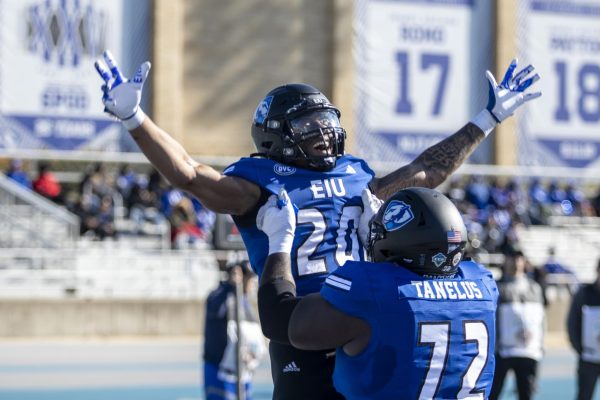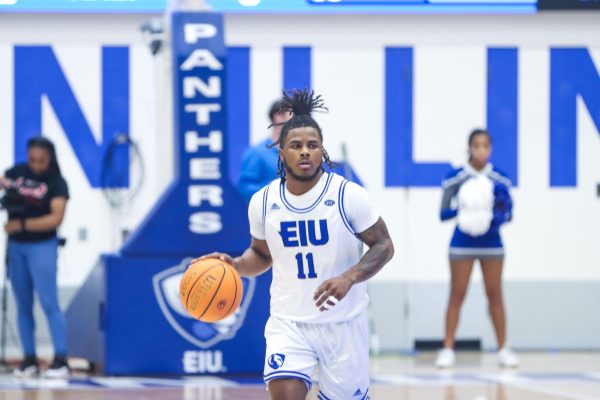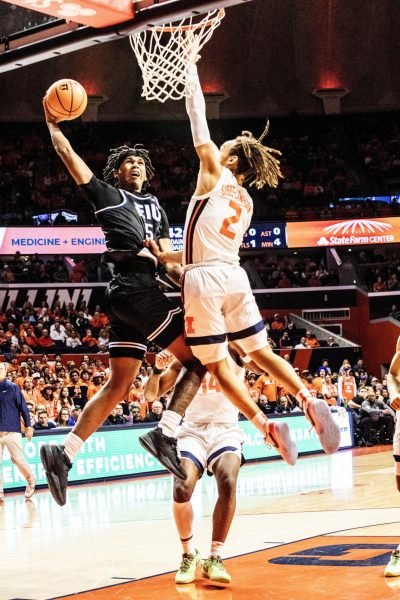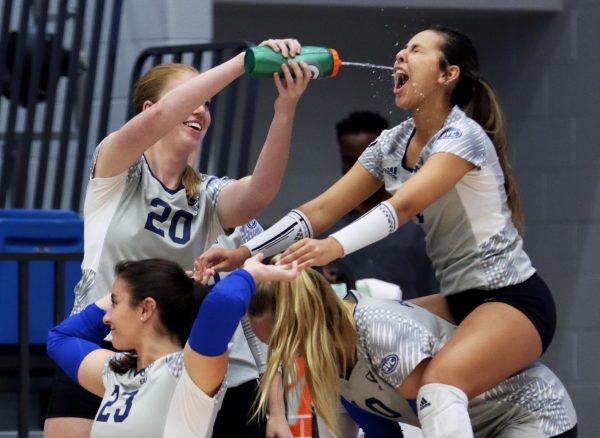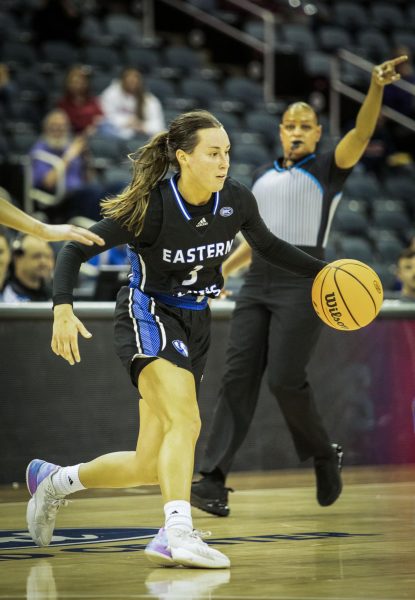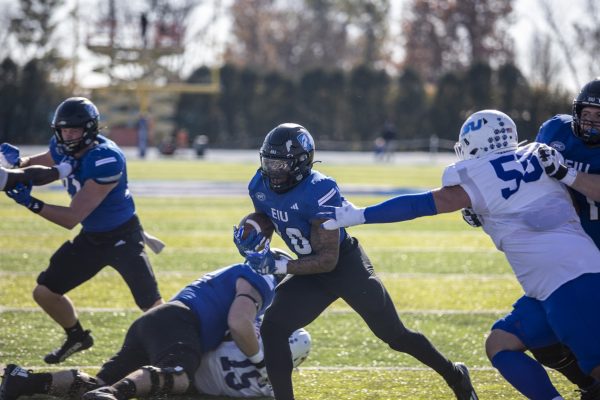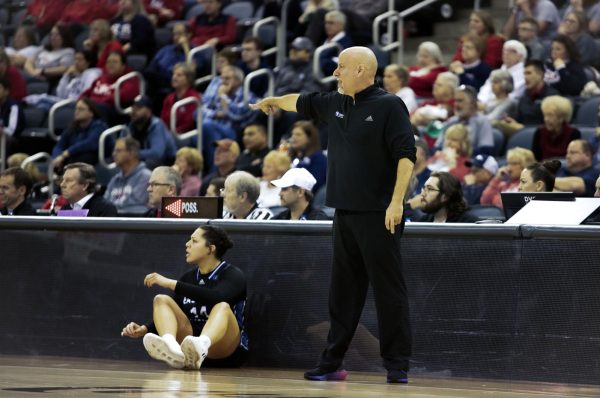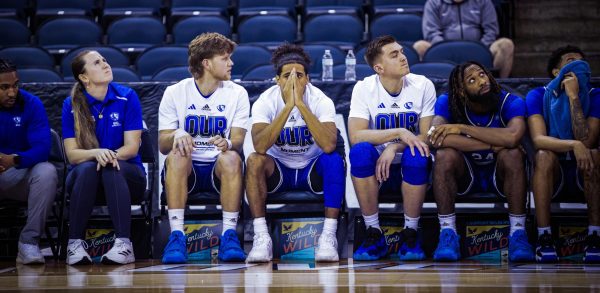Starting 5 returns for Eastern, provides stability
File Photo | The Daily Eastern News
Eastern’s Josiah Wallace backs away from Jacksonville State defenders in the game on Feb. 28 in Lantz Arena. Wallace had 23 points, but Eastern lost 89-84 in double overtime.
October 22, 2019
The Eastern players will, more or less, reprise their various roles from last season when the Panthers play Missouri St. Louis in an exhibition game at Lantz next Wednesday.
Eastern is the only team in the conference to bring back the same starting lineup that trotted out each game at tipoff: juniors Josiah Wallace and Mack Smith, as well as seniors Rade Kukobat, JaQualis Matlock and Shareef Smith.
Head coach Spoonhour does not expect to play a rotation that extends 12 deep, but the competition observed in practice, with both seasoned veterans and newcomers vying for every last minute, will force players to make adjustments if they are not contributing to the extent that they might have thought.
This continuity, and the time that has elapsed since the tournament, will give other Ohio Valley Conference teams a heavy supply of scouting reports to work with. Wallace, having been selected for the preseason All-OVC Men’s basketball team, will be on every radar wherever they go this season.
“Every coach in the league is going, ‘Hey, Josiah. How are you,’” Spoonhour said.
“They all know he is. So from the beginning, he has been a top guy on the scouting report, and so what he is going to run into is, basically, the defense; if it’s not geared to stop him, everyone’s going to be aware of him.”
That said, Spoonhour is not particularly concerned about Wallace’s ability to adapt to the high volume of traps that defenses, familiar with his scoring prowess and knack for getting to the line, will likely throw at him next season.
“We definitely have pieces this year that are going to help us out and make my job a little easier and make everybody else’s jobs a little easier,” Wallace said.
“It’s definitely going to be different, but it’s definitely going to be a better year for sure. I believe that and we’re ready to get the season running.”
He cited Marvin Johnson, who joined the Panthers this offseason after two NJCAA Championships at Coffeyville Community College, as someone with the potential to divert a defense’s attention away from him.
The Panthers drilled triples at a 37 percent clip last season, enough to put them at third in the conference when it came to hitting the three ball through 32 games. In the offseason, however, the NCAA Playing Rules Oversight Panel elected to adopt the International basketball distance of 22 feet, 1 3/4 inches for the 2019-20 season.
“I just feel like there are going to be a lot more teams trying to post the ball, and there may be fewer guys that you have to think about defending,” Spoonhour said. “That might spread you out a little bit less. We kind of have to see how it goes.”
Ahead of the 2008-09 campaign, the last time the league opted to move the line back, NCAA officials decided to push the line back a foot from where it had been the season prior.
This alteration triggered a plunge in three-point percentage between the two seasons, from 35.2 percent in 2007-08 to 34.4 percent in 2008-09, according to the NCAA.
From where Spoonhour sees it, players who shot around 33 percent last season, those for whom the three-point line adjustment will be of little concern, can seamlessly transition to the new distance without a second thought.
“Honestly, I have not thought about it too much,” Wallace said.
“I can’t tell too much difference, honestly. I guess for some guys it’s a bigger deal than others.”
But, on the other hand, he could easily see how a player with a 30 percent three-point percentage a year ago could find it unmanageable and tumble to a below average rate if they continue jack up from behind the arc, attempts that are sure to be rebuffed by the coaching staff.
Smith and Wallace shot 2.5 and 1.9 threes per game at 35 and 37 percent respectively, but, relative to OVC teams, the Panthers attempted such shots at an average level output.
“If you are shooting under 20 percent, it’s like, ‘hey, go get something else now,” Spoonhour said.
“I think that’s how the adjustment will be. It will probably be among the individual player. I don’t think there are many guys that that foot is going to impact, but its impacting some of them. I have already seen it in practice a little bit.”
When it came to defending the three, Eastern ranked last in allowing opposing teams to connect on 38 percent of their looks.
Spoonhour does not believe that the issues posed by opposing offenses behind the three-point line pertained to an inability to close out on sharpshooters, rather it concerned issues with staying in front of the basketball and making the most cogent decision in terms of where to apply their attention. That ultimate judgment came down to whether they would congest lanes to the basket and prevent a layup or, conversely, send a help defender out on the perimeter.
He emphasized that he recruited players who possessed the skills to keep themselves in front of the ball handler, while also constructing a three-point centric defensive approach.
That does not mean their evolved approach, according to Spoonhour, will ignore their duties inside.
“You have to be able to guard inside,” Spoonhour said. “If you can’t guard inside, they are just going to throw it in there and kill you, and they do not even have to shoot threes.”
Tom O’Connor can be reached at 581-2812 or [email protected].

































